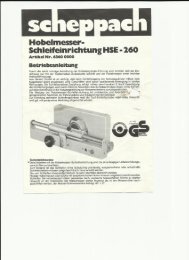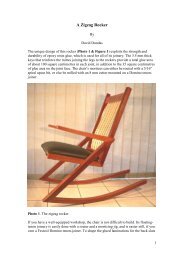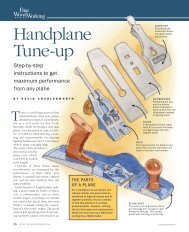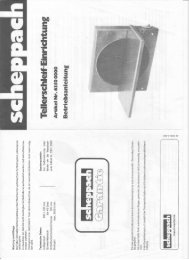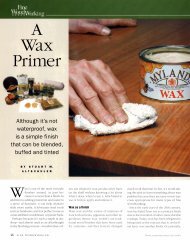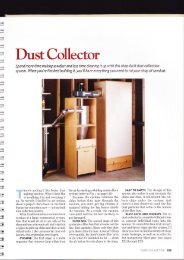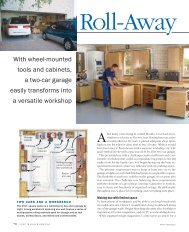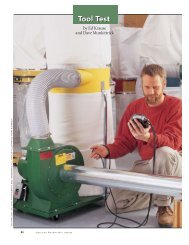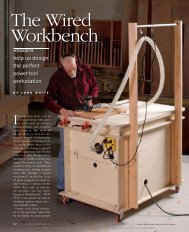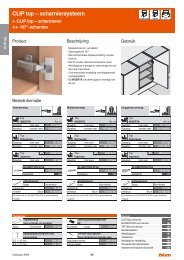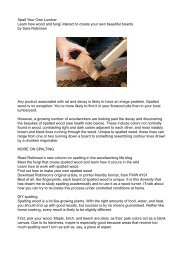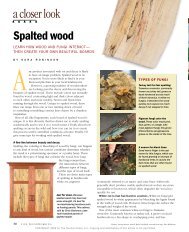Shopmade Catches and Latches
Shopmade Catches and Latches
Shopmade Catches and Latches
- No tags were found...
You also want an ePaper? Increase the reach of your titles
YUMPU automatically turns print PDFs into web optimized ePapers that Google loves.
when closed yet fit completely within thedoor stile when in the fully opened position.Begin by drilling the knob holethrough the stile. Then make a cardboardcutout of the spinner, sized so that it won’treach into the door-panel groove. Locatethe mortise by swinging the cutout in a 90°arc around the door-knob hole. The widthof the mortise should be about a third thethickness of the door frame—usually 1 ⁄4 in.for a 3 ⁄4-in.-thick frame.Once the mortise is complete, shape <strong>and</strong>drill the spinner <strong>and</strong> check the fit with theknob attached. If all works well, pin it inplace with a small brad or brass escutcheonpin. The spinner should not beglued, because there’s a great risk of gluegetting onto the knob shaft, which willmuck up the works.I aim for close tolerances between theknob shaft <strong>and</strong> matching hole. For mostcabinet doors I use knobs with 1 ⁄2-in.-dia.shafts ( 3 ⁄8 in. dia. for very small doors). Tomake life easier, I shape all knob tenonswith a plug cutter, chuck them into thelathe <strong>and</strong> turn the knob proper. If you thinkabout it, the knob shaft is the only criticalpart of the process. The 1 ⁄2-in.-dia. shaftmust fit precisely in the matching holebored into the door. The plug cutter eliminatesthe most difficult portion of the task.For a 1 ⁄2-in.-dia. knob shaft, drill a 33 ⁄64-in.-dia. hole through the door stile <strong>and</strong> a 1 ⁄2-in.-dia. hole through the spinner. Now theknob will spin freely in the door frame yethold the spinner securely. Next, with thespinner in the closed position, align thegrain of the knob with the grain of the doorframe. Then turn the spinner into the openposition <strong>and</strong> pin it. This detail makes it easyto tell whether the spinner is in the open orclosed position.After 30 years as a woodworker, I wassome proud of myself for coming up withthis idea of installing the spinner in thedoor frame. Then in 1996, while shootingphotos for The Shaker Legacy (TheTaunton Press, 1998), I came across a smallchest with drawers <strong>and</strong> doors at the ArtComplex Museum in Duxbury, Mass., inwhich the door knob passed through amortise in the edge of the door. Althoughthe spinner itself was missing, it was clearthat the Shakers had the same bright idea160 years ago. Chris Becksvoort is a contributing editor.Chop out the mortise. Becksvoort chiselsout the mortise by h<strong>and</strong>.Predrill for the pin. Toavoid splitting the spinner,drill a hole for the escutcheonpin.The knob should slide in with a little pressure.The spinner must swing freely <strong>and</strong>should be hidden when the latch is open.Secure the spinner <strong>and</strong> knob with a pin. Instead of glue, use a small brad or escutcheon pin<strong>and</strong> drive it in using a nailset.MARCH/APRIL 2002 47



